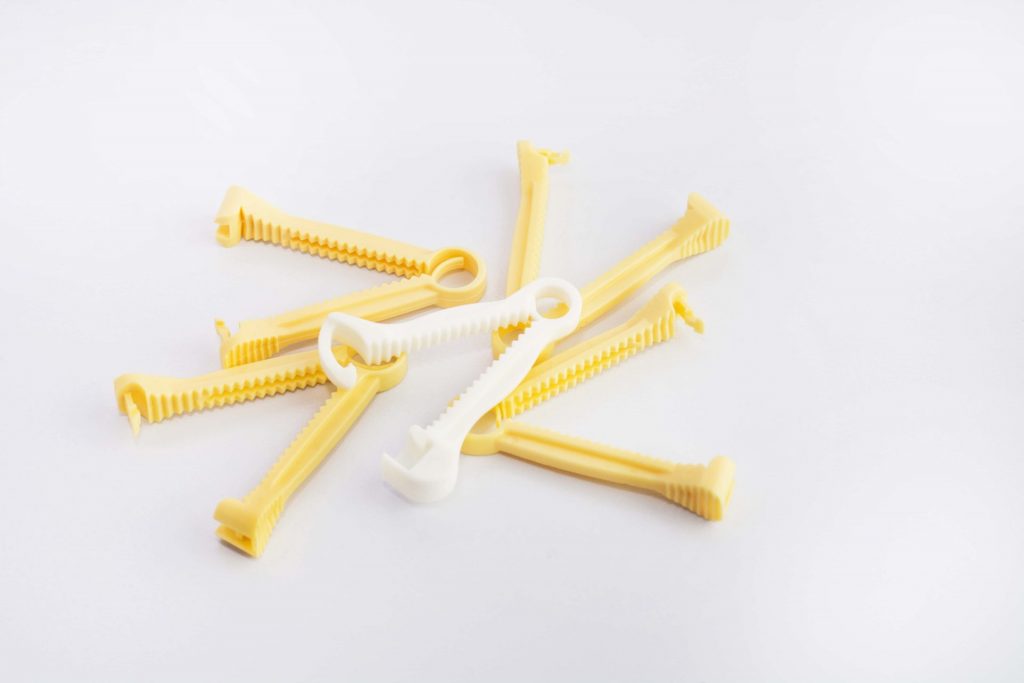Delayed cord clamping is yet another example of how as parents we should look to nature for the answer!
What I’m learning as a new parent is that oftentimes “less is more”. In other words, doing less (or nothing) in certain situations can actually be more beneficial for our children than “doing something”.
Greg and I believe that delayed cord clamping brings so many benefits to the table. In today’s post, I’ll share why we think that and why a growing number of mama’s and science itself is starting to think so too.
As you’re writing your birth plan with your partner, take the time to do the research and make a decision BEFORE the birth of your child. Don’t just take our word for it- do what you believe is best!
What Is Delayed Cord Clamping
Delayed cord clamping is pretty straightforward to explain:
It’s when the umbilical cord isn’t clamped right away after birth.
The simple act of not clamping the cord immediately after birth can have a profound effect on your little one. Allowing billions of red and white blood cells, as well as other important bodily fluids to make their way back to baby.
Only in recent history has the concept of “immediate cord clamping” been in practice. This is when a clamp is placed on the umbilical cord immediately after birth. Thus blocking the returning blood and fluid from within the placenta that your baby needs.
How Long to Wait Until Cutting The Cord?
The exact time of when to clamp the cord isn’t completely agreed upon…
The WHO recommends waiting until 1-3 minutes before clamping.
However, the exact timing of when to clamp the cord varies from baby to baby. The most important indicator of when to clamp the cord is to look at the umbilical cord itself!
I know right- shocker 😉
A good indicator of when to clamp the cord is when it…
- Stops pulsating
- Is limp
- Turns white
This could take 3 minutes, it could take 10! It will vary from baby to baby.
The important thing is that when the above three criteria are met, it’s a good indicator that baby has received all remaining fluid within the cord. It would then be time to clamp and cut!

Benefits Of Delayed Cord Clamping
1. Increased Iron levels- lower chance of Anemia
One of the biggest benefits of delayed cord clamping is the return flow of blood from the placenta and umbilical cord back into baby. Within 5 minutes of letting the cord empty back into baby, an estimated 50% of the baby’s iron is returned.
This increased store of iron is then used up within baby’s first 6 months of life. At which point most babies start eating solid food! Hopefully iron-rich foods!
See!! Nature has a plan for everything. It’s amazing when you step back and think about it 🙂
Iron’s role within the body
Iron plays an incredible role within the body. If you’ve ever cut your finger and sucked on it and tasted a slightly metal taste- that’s the iron within your blood!
Babies need proper iron levels to create hemoglobin. Hemoglobin’s role is to carry oxygen through the bloodstream, something that’s very important as baby’s respiratory system comes online for the first time!
When iron levels are too low baby may become anemic and display the following symptoms
- Pale
- Slow weight gain
- No appetite
- Irritable
- Develop more slowly
Now if your child wasn’t able to have their cord clamping delayed- don’t freak out! Babies are born with iron reserves that come from mama. On top of that, babies will get some additional iron through breast milk!
Your baby still has iron, just not as much compared to a baby that had their cord clamping delayed.
Supplementation
If you have a concern about the iron levels of your little one, be sure to consult with your family doctor or pediatrician!
Generally speaking, be very careful about assuming your child needs additional iron supplementation. Too much iron through the form of supplementation can be harmful to your child. Instead, focus on eating iron-rich foods for mama, and for baby once they’re ready for solids!
2. Improves early brain development
Another huge benefit of delayed cord clamping is the improvement of early brain development for newborns! As a result of waiting to clamp the cord, more red blood cells are returned to baby.
This means more iron for oligodendrocytes which produce myelin. Myelin form protective barriers around nerves and are crucial for transporting electrical impulses from the brain to the rest of the body.
In simpler terms, by allowing the red blood cells to return to baby- it improves things like fine motor skills, and sensory abilities.
3. Increased Oxygen Levels
Studies have shown that full term babies who had their cord clamping delayed had increased oxygen levels compared to those who were clamped immediately.
This is again a result of higher hemoglobin levels which help to not only carry oxygen throughout the body, but also to regulate it.
This is key because as baby’s respiratory system comes online and oxygen levels increase, the need for oxygen regulation is greater.
As it happens to turn out, supplemental oxygen is the most widely used agent when it comes to neonatal care. Approximately 1 in 10 babies receive it. With many many babies having their cords clamped immediately- there may be a correlation here worth exploring! Are babies who have their cord clamped immediately more likely to have supplemental oxygen? I couldn’t find a definitive answer, but reasoning could led us to this conclusion. You be the judge!
Supplemental oxygen can be dangerous to baby and can cause Retinopathy of Prematurity, Chronic Lung Disease, Hemorrhaging or even Lymphatic Leukemia if proper precautions aren’t followed.
This is something I did not realize, and with the high rate of babies needing it- it’s something that I’ll want to learn more about before my next child is born!
4. Huge Positive Impact For Preemies!
For those babies who are preemies there are numerous studies on the benefits of delayed cord clamping such as
- Higher Blood Pressure
- Increased blood volume
- More optimal oxygen flow
- Fewer days on oxygen and ventilation
- Less likely to need blood transfusions
- Decreased chance of brain bleeds
It would seem that delaying cord clamping is even more important for preemies than it is for full term babies!
What I’ve learned from this so far is this. The umbilical cord is what’s given your baby life for 9 months in the womb. So it only makes sense to continue to let it do its job for a few more minutes after birth.
This is clearly evident in this preemie example.
5. Stabilizes Heart Rate and Blood Pressure
Immediately after birth- there are a TON of changes happening for baby. For the first time, life support systems like the respiratory system are becoming independent.
Keeping the umbilical cord attached for as long as possible helps to bridge the gap between being in the uterus inside mama, and surviving on it’s own in the outside world.
Keeping the cord attached allows for any remaining blood, and thus oxygen to come into the body which helps to the heart rate and blood pressure to stabilize.
6. It’s Life Saving!
Two studies done in 2017 from the University of Sydney involving 3,000 babies with delaying cord clamping at least 60 seconds after birth found some amazing results!
“We estimate that for every thousand very preterm babies born more than ten weeks early, delayed clamping will save up to 100 additional lives compared with immediate clamping,” said the University of Sydney’s Associate Professor David Osborn, the review’s lead author and a neonatal specialist at Royal Prince Alfred Hospital.
“This means that, worldwide, using delayed clamping instead of immediate clamping can be expected to save between 11,000 and 100,000 additional lives every year.”
This is truly a great discovery and is yet another very strong reason to consider delayed cord clamping for your child.
Delayed Cord Clamping Is How Nature Intended Birth
There’s something to be said about sitting back and observing nature and thinking about how we can apply some things within our own lives.
For instance, not a single animal in the wild once a baby is born attempts to bite off the umbilical cord. Instead, it falls off when it’s ready! Humans are the only ones on this planet who are in a mad rush to clamp the cord immediately after birth!
Think about that for a moment….
As a natural minded mama, I believe that Nature’s intuition (which works through God’s design) should be followed and closely examined. Instead of being swept away and ignored as what’s so commonly done by many today.
Many studies have been done on the benefits of delayed cord clamping, if only we listened to nature a little more often, we could potentially save ourselves so much grief later on!
How to Request Delayed Cord Clamping
Maybe you’ve decided that you would like to delay the clamping of your newborns umbilical cord. That’s great! But how do you request it?
Three things to keep in mind here…
-
- Talk with your doula, midwife or healthcare provider! Be sure to bring this up as soon as you can. The more time you have to discuss your preferences with them. The better!
- Add delayed cord clamping to your birth plan! Your birth plan is a great place to indicate your desire to wait to clamp the cord. You are writing a birth plan right? Hopefully you are! If not, check out our post on what a birth plan is and why you should consider one. Sitting down and taking the time to write a birth plan with my husband was one of the best things we did to prepare for our child’s birth. If you give it your full effort- I think you’ll agree!
- Be sure to remind your provider several times once in labor that you wish to have a delayed cord clamp. Healthcare providers are very busy individuals and most don’t mind the friendly reminder! This especially rings true in a hospital setting where one doctor is seeing many patients at once.
Risks of Delayed Cord clamping
There are some risks associated with delayed cord clamping- Jaundice being the most prevalent. However, they’re very small and the benefits appear to outweigh any risks.
Increase Chance Of Jaundice
According to the Cleveland Clinic, Jaundice is a condition in which the skin, sclera (whites of the eyes) and mucous membranes turn yellow.
It’s caused by an elevated amount of bilirubin which is a natural waste product of red blood cells. This makes sense because delayed cord clamping increases the amount of blood within baby. With baby’s liver not fully functioning yet, it struggles to keep up to process the bilirubin out of the body. The result is Jaundice.
Jaundice is common in babies born before 38 weeks and preemies. In most cases, no treatment is necessary and the risk of further complications is rare.








0 Comments